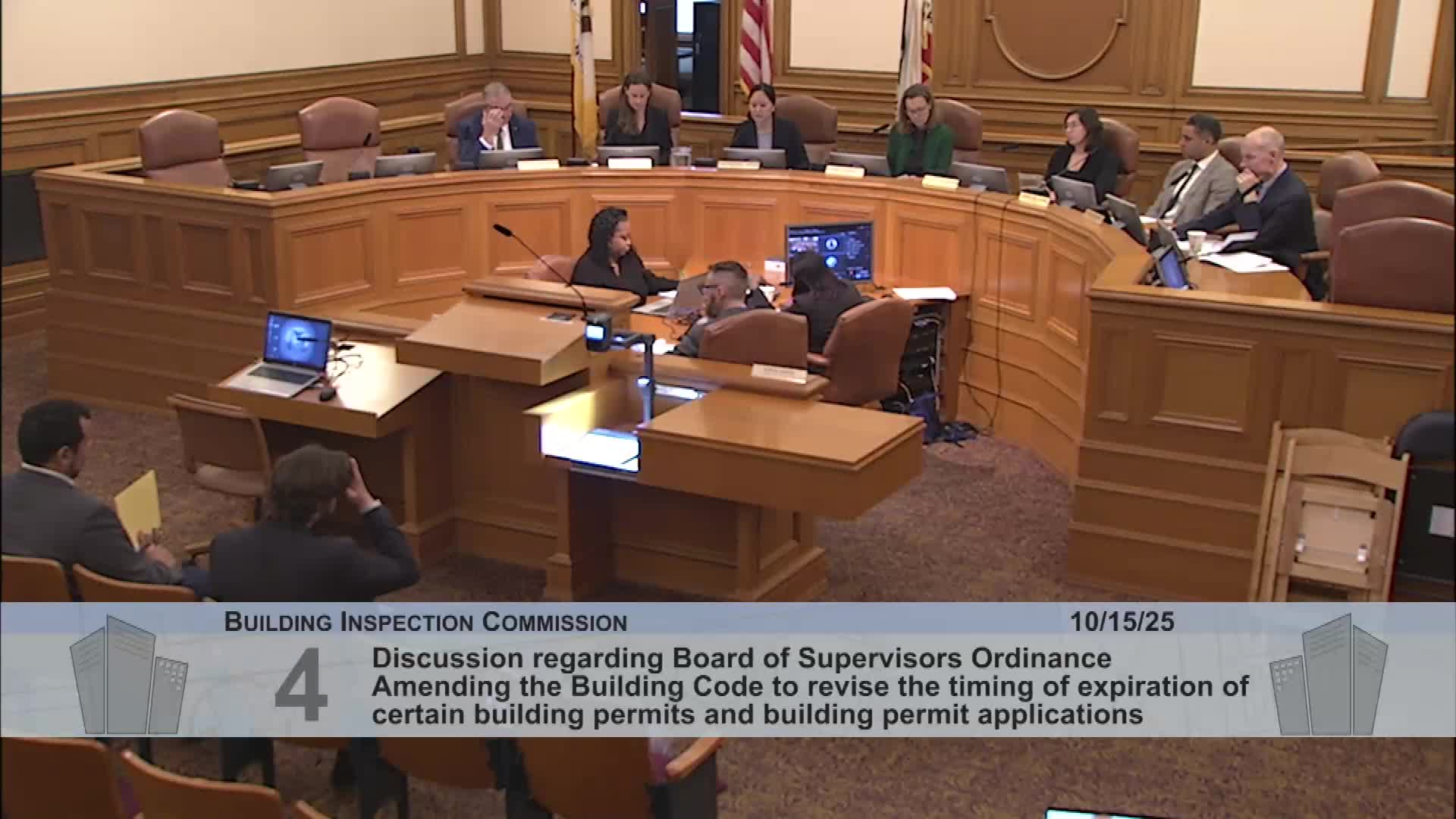Commission backs new administrative bulletins to standardize post‑earthquake inspections for concrete and pre‑Northridge steel buildings
October 15, 2025 | San Francisco City, San Francisco County, California
This article was created by AI summarizing key points discussed. AI makes mistakes, so for full details and context, please refer to the video of the full meeting. Please report any errors so we can fix them. Report an error »

The Building Inspection Commission unanimously recommended approval of a package of administrative bulletins and an appendix intended to standardize post‑earthquake assessment and repair for concrete buildings and for pre‑Northridge welded steel moment‑frame buildings.
Laurel Matthews of the Office of Resilience and Capital Planning, who led the presentation for DBI, said the updates to AB 099 incorporate recent FEMA guidance (FEMA P‑2335) and align the bulletin with 2025 building code updates to clarify when and how engineers should calculate “capacity loss” following earthquake damage. Matthews said the new steel building administrative bulletin relies on updated guidance adapted from FEMA 352 (originally produced after the 1994 Northridge earthquake) and has been revised to conform with modern engineering standards such as ASCE 41 and recent Stanford research.
Steve Harris, vice chair of the Code Advisory Committee and chair of its structural subcommittee, described the appendix edits as work led by many of the original FEMA 352 authors and Stanford researchers and said the revised guidance will provide DBI and owners with up‑to‑date procedures for inspecting and repairing these building types.
Commissioners and staff clarified how the documents will be used. Steve Harris emphasized the bulletins are not intended for the initial rapid tagging process after an earthquake; rather they are tools for subsequent, more detailed engineering evaluations when a building is yellow‑ or red‑tagged or when there is evidence of hidden or significant structural connection damage. The documents explain how to determine when a building has lost a threshold of lateral capacity (the existing code reference is a roughly 33% reduction) that may trigger upgrades in addition to repairs.
Commissioner questions focused on dissemination and implementation: who will use the documents, how DBI will ensure building owners’ engineers and field teams are aware of and can access the guidance, and whether inspections required by the guidance are mandatory when thresholds are met. Laurel Matthews said the reports and evaluations would typically be produced by a building owner’s design professional or engineer; DBI staff would use the documents as a reference when reviewing those reports.
Commissioner Ming moved to recommend approval of items 5, 6 and 7 (the steel administrative bulletin and appendix and AB 099); the motion passed unanimously.
Laurel Matthews of the Office of Resilience and Capital Planning, who led the presentation for DBI, said the updates to AB 099 incorporate recent FEMA guidance (FEMA P‑2335) and align the bulletin with 2025 building code updates to clarify when and how engineers should calculate “capacity loss” following earthquake damage. Matthews said the new steel building administrative bulletin relies on updated guidance adapted from FEMA 352 (originally produced after the 1994 Northridge earthquake) and has been revised to conform with modern engineering standards such as ASCE 41 and recent Stanford research.
Steve Harris, vice chair of the Code Advisory Committee and chair of its structural subcommittee, described the appendix edits as work led by many of the original FEMA 352 authors and Stanford researchers and said the revised guidance will provide DBI and owners with up‑to‑date procedures for inspecting and repairing these building types.
Commissioners and staff clarified how the documents will be used. Steve Harris emphasized the bulletins are not intended for the initial rapid tagging process after an earthquake; rather they are tools for subsequent, more detailed engineering evaluations when a building is yellow‑ or red‑tagged or when there is evidence of hidden or significant structural connection damage. The documents explain how to determine when a building has lost a threshold of lateral capacity (the existing code reference is a roughly 33% reduction) that may trigger upgrades in addition to repairs.
Commissioner questions focused on dissemination and implementation: who will use the documents, how DBI will ensure building owners’ engineers and field teams are aware of and can access the guidance, and whether inspections required by the guidance are mandatory when thresholds are met. Laurel Matthews said the reports and evaluations would typically be produced by a building owner’s design professional or engineer; DBI staff would use the documents as a reference when reviewing those reports.
Commissioner Ming moved to recommend approval of items 5, 6 and 7 (the steel administrative bulletin and appendix and AB 099); the motion passed unanimously.
View the Full Meeting & All Its Details
This article offers just a summary. Unlock complete video, transcripts, and insights as a Founder Member.
✓
Watch full, unedited meeting videos
✓
Search every word spoken in unlimited transcripts
✓
AI summaries & real-time alerts (all government levels)
✓
Permanent access to expanding government content
30-day money-back guarantee

